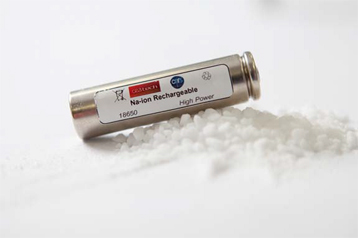© Cyril
FRESILLON/CSE/CNRS Photothèque
Assembling a
cell to test sodium-ion (Na-ion),
battery
materials in a glove box.
(November 29, 2015) After two years of research, a French team, mostly including
researchers from the CNRS and CEA within the RS2E network on electrochemical
energy storage (Réseau sur le stockage électrochimique de l'énergie)1 have just
designed an alternative technology to Li-ion for application in specific
sectors. The researchers have developed the first battery using sodium ions in
the usual “18650” format, an industry standard. The main advantage of the
prototype is that it relies on sodium, an element far more abundant and less
costly than lithium. The batteries have displayed performance levels comparable
to their lithium counterparts, and this new technology is already attracting
industrial interest. It could be used to store renewable energies in the
future.
© Vincent
GUILLY/CEA
Standard
"18650" sodium-ion (Na-ion) battery placed on a heap of salt (NaCl).
This is the
first-ever sodium battery in this format.
The idea for using sodium in batteries dates back to the
1980s. At the time, lithium was preferred to sodium as the material of choice
and it has been widely used ever since for portable electronic devices such as
tablets, laptops and electric vehicles. However, lithium has a major drawback
in that it is fairly rare on our planet. Teams from the RS2E (with the CNRS as
the leading partner) therefore turned towards sodium, a thousand times more
abundant. They developed sodium-ion battery prototypes where sodium ions move
from one electrode to another in a liquid during the charge and discharge cycles.
© Cyril
FRESILLON/CSE/CNRS Photothèque
Plugging a cell
for basic research on sodium-ion (Na-ion) battery materials.
Its performance
will thus be electro-chemically tested.
The first step was to find the ideal “recipe” for the
positive electrode (cathode) of the battery. Six partner laboratories of the
RS2E (see list below) were involved in the project with the goal to find the
right composition for this sodium electrode. The development of a future
prototype was then entrusted to CEA, a member of the RS2E network. In only six
months, CEA was able to develop the first sodium-ion prototype in the “18650”
format, that of the batteries found on the market, i.e. a cylinder 1.8cm in
diameter and 6.5cm in height. This should facilitate technology transfer to
existing production units. Other international laboratories also work on this
technology, but none of them has yet announced the development of such a
“18650” prototype.
© Vincent
GUILLY/CEA
Standard
"18650" sodium-ion (Na-ion) batteries,
the first-ever
in this format.
This second stage made it possible to move from the
laboratory scale (synthesis of several grams of cathode material) to the
“pre-industrial” scale (synthesis of 1kg batches). It enabled the production of
batteries with unmatched power performance levels. This new technology is
already showing promising results. Its energy density (the quantity of
electricity that can be stored by Kg of battery) amounts to 90Wh/kg, a figure
already comparable with the first lithium-ion batteries. And its lifespan—the
maximum number of charge/discharge cycles that a battery can withstand without
any significant loss of performance—exceeds 2,000 cycles. But most of all,
these cells are capable of charging and delivering their energy very rapidly.
The main advantage of the technology is that it does away with lithium, a rare
element only found in specific locations, contrary to sodium. Its other
advantage is financial, as using sodium could make it possible to manufacture
less expensive batteries.




